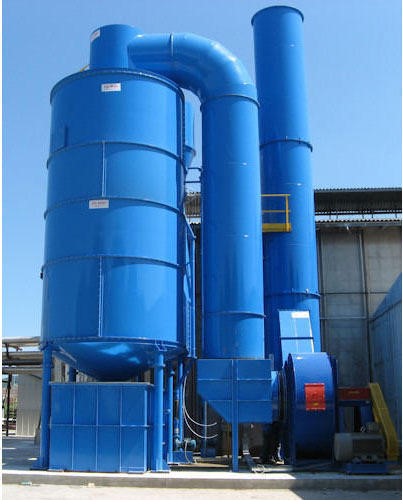This guidance sheet is part of a series of guidance sheets. It should be read with our odour guidance for businesses.
On this page
Description
Chemical scrubbers remove odour causing particles and some gases from air stream exhaust. They work by dissolving or absorbing the odour causing particles into the scrubbing media, which is traditionally a liquid. Modern chemical scrubbers can also be dry powders (dry scrubbers, venturi reactors), or slurries.
Example of industrial chemical scrubbing. Image provided by Chris Bydder.

Type of control
Chemical.
When you would use this
Chemical scrubbers are very popular odour reduction methods and can be used in a variety of industries that produce fumes/gases.
Suitable for: commonly used to control ammonia, chlorine, sulphur, carbon dioxide, or highly acidic gases including fluoride. Chemical scrubbing can also be used to remove mercury.
Industries that would use this: generally, industries with chemical processes, metal finishing, sewage treatment, other industrial applications that produce fumes/gases will find chemical scrubbing the most beneficial.
Details and considerations
There are many different chemical scrubbing options, which one you use at your business or site will depend on several factors:
- The type of odour causing particles generated within your fumes or exhaust gases.
- The concentration of the odour causing particles.
- The temperature of the fumes or exhaust gases produced.
- The efficiency rate required by the chemical scrubber. This can be determined using the above factors, as well as by taking into account any other odour treatment or pre-treatment methods you are implementing at your business or site.
- It is important to be aware of the pH of your acidic gases (pH >7) or ammonia, as this may impact the scrubber media you use.
A suitably qualified professional can assist in the selection of the most appropriate type of chemical scrubber for your business. For information on engaging a suitably qualified professional, please see EPA's information about engaging a consultant.
Once implemented, there are several considerations to keep in mind:
- To achieve optimal odour or VOC removal it is important to ensure appropriate contact time between the fumes or exhaust gas and the scrubbing media. The length of time needed will depend on the factors above, and the type of scrubber selected.
- If poorly maintained, chemical scrubbers can lead to excess growth of harmful microorganisms which could pose a risk to human health. It is for this reason that it is important to maintain your chemical scrubber and replace or refresh the scrubbing media as often as required. The frequency of refreshment or replacement will depend on the exact chemical scrubber you implement, the concentration of odour causing particles in the air stream, and air stream flow rate. In some instances, scrubbing media may require daily changing.
- While chemical scrubbing removes odour causing particles from fumes or exhaust gases, it does not eliminate them. Instead, they become trapped within the scrubber media and will need to be reused or disposed of safely when replaced.
- While some soiled chemical scrubber media can be reused and made into new products, many will need to be disposed of safely. This can include further processing. In that instance, it will be important to refer to proper methods to handle hazardous waste. This can be accessed through the WorkSafe document Safe handling of industrial waste: A practical guide for workplaces. Additionally, your supplier would have information on this.
Read more
Safe work Australia code of practice - Managing risks of hazardous chemicals in the workplace.
This page was copied from EPA's old website. It was last updated on 26 June 2019.
Reviewed 1 October 2020



